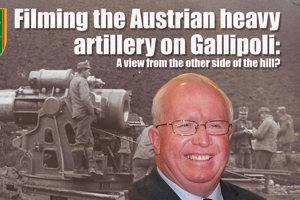
Event Details
- 24 Jun 25 19:30 - 24 Jun 25 21:00
- Lecture
- Zoom Talk
June 24th: Christopher Pugsley: Filming the Austrian Heavy Artillery on Gallipoli: A view from the other side of the hill?
The Zoom talk will be open from 19.15 so please join promptly. Talk will begin at 19.30 UK time.
To register for the talk please email Warren Smith on: [email protected]
To view our archive of historical lectures, please subscribe to the Gallipoli Association YouTube channel, it's free! https://www.youtube.com/@GallipoliAssociation/videos

Bulgaria’s alliance with Germany and entry into the war in September 1915, enabled Austria-Hungary to send two heavy artillery batteries to aid the Ottoman 5th Army at Gallipoli in November 1915. Motormörser-Batterie No. 9 [Motor Mortar Battery No.9] equipped with four 24cm Howitzers deployed to the Suvla-Anzac sector and No. 36 k.u.k 15 cm- Haubitzebatterie Nr. 36 (Howitzer Battery No.36), equipped with four 10.4 cm Feldkanone M. 15, went further south to the Cape Helles sector. Accompanying the artillery was an official Austro-Hungarian film crew who recorded both the trek through Turkey and scenes from the front including views of how it looked immediately after the withdrawal.
These images capture ‘the other side of the hill’ in the closing stages of the Gallipoli Campaign. It is a critical addition to the growing number of films taken of the campaign. For the Allies, the large number of official French films, together with Ellis Ashmead-Bartlett’s sole British contribution, and now a growing list of films from the Central Powers including, German, Austro-Hungarian and Turkish film. Most of which have been hiding in plain sight, giving us a comprehensive filmed record of the campaign.
Chris Pugsley ONZM is a New Zealand military historian who has made significant contributions to the understanding of New Zealand's role in the Gallipoli campaign. His groundbreaking work began in 1984 while serving as an officer in the New Zealand Army, when he worked on a television documentary about New Zealand's involvement in Gallipoli and authored "Gallipoli: The New Zealand Story." After retiring from the army in 1988 to pursue history full-time, Pugsley built an impressive academic career that included positions at the Royal Military Academy Sandhurst and University of Canterbury. His expertise in Gallipoli, combined with his military background, provides unique insights into the tactical and strategic aspects of the Gallipoli Campaign.
